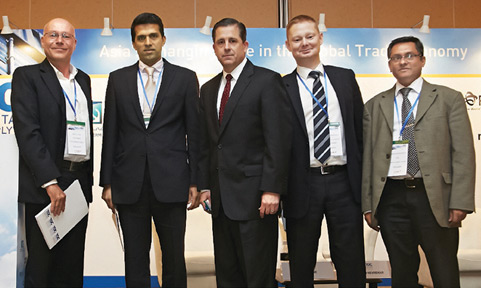Impact of mega vessels on terminal operators
The 18th TOC Container Supply Chain Asia conference, took place
recently at the Marina Bay Sands Hotel, Singapore, as part of Singapore
Maritime Week (SMW).
The TOC Container Supply Chain Asia conference discussed the impact
of ultra-large volumes of containers on maritime terminal operations and
performance, a TOC Events spokesman said.
Convened under the theme Asia's Changing Role in the Global Trade
Economy, TOC CSC Asia 2014 provided a macro-to-micro perspective on
global and regional container supply chains and trade, bringing together
a diverse group of stakeholders to explore present challenges and
solutions.
|

From left: Partner, CTI Consultancy, Andy Lane, General
Manager, Liner Procurement and Operations, Ocean Carrier MOL
(Asia), Rohan Nevrekar, Executive Director, Georgia Ports
Authority, Curtis Foltz, Group Commercial Manager,
Gulftainer, Simon Sundboell and CEO, Shippers’ Academy,
Colombo, Rohan Masakorala. |
In a new format designed to promote peer group networking and
knowledge exchange, the 2014 event incorporated two concurrent debating
fora: the Container Supply Chain (CSC) Conference which is an
executive-level discussion forum focused on international trade,
container shipping, port development and logistics and Tech TOC
Conference aimed at operational executives and focused on the
practicalities of port and terminal performance, with in-depth debates
on facility design, automation, operations, equipment and technology
from berth to gate.
Regional leaders enlightened participants on challenges the terminal
industry will face in the coming decades. The experts discussed how
terminals can anticipate and manage the dramatic impact on day-to-day
operations.
Among the discussions highlighted were combination of dramatic vessel
upsizing and new alliance strategies such as P6 and G3 has been the way
for the global container shipping industry to return to sustainable
profitability by making deep cuts to operating costs and achieving
greater economies of scale. While this is hailed and might be good news
for carriers, does the same hold true for the container terminal sector?
On the operational side, the concentration of large container volumes
into a single weekly call will put a significant strain on the capacity
of a maritime terminal to work the ship, on the quay and landside. For
terminals handling, origin and destination cargo, the container surge
will also take a big toll on gate operations.
Truck drivers delivering and picking up containers might have to
contend with increased gate congestion and turn times stretching to
hours.
With truck and rail carriers faced with handling twice the volume of
cargo from one vessel, it is also far from clear whether hinterland
logistics infrastructure beyond the gate is up to the challenge of
efficiently moving larger volumes of boxes at any one time.
In this climate, container terminal productivity has never been more
important. While terminals can, and do invest billions of dollars in
technology solutions to raise productivity, is this enough? Are existing
operational norms, such as employee shift structures and established
logistics processes, sufficiently flexible or creative to cope with the
coming tidal wave of containers that the lines will deliver in a single
call? In a session titled 'The Need for Speed - Terminal Productivity
and Supply Chain Performance', speakers discussed the implications for
ports and customers and debated how operators can survive the evolving
demands. |

